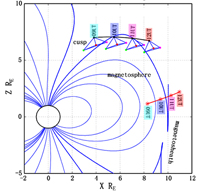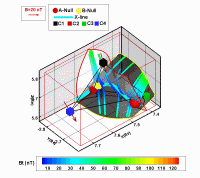Multiple rifts in Earth's magnetic shield
20 January 2010
The Earth's magnetic field protects our planet from most of the permanent flow of particles from the solar wind. Fissures in this magnetic shield are known to occur, enabling the solar wind to penetrate our near-space environment. A study based on data collected by the four ESA Cluster satellites and the CNSA/ESA Double Star TC-1 spacecraft, provides new insight into the location and duration of these ruptures in the Earth's magnetic shield.This study reports the observation of fissures on the Sun-facing side of the Earth's magnetic shield – the dayside magnetopause. Fortunately, these fissures don't expose Earth's surface to the solar wind; our atmosphere protects us, even when our magnetic field doesn't. However, clear effects have been detected high in the upper atmosphere and in the region of space around Earth where satellites orbit.
The dominant physical process causing these cracks is known as magnetic reconnection, a process whereby magnetic field lines from different magnetic domains collide and reconnect: opening the closed magnetic shield. Magnetic reconnection is a physical process at work throughout the Universe, from star formation to solar explosions to experimental fusion reactors on Earth. However, the conditions under which it occurs and how long it lasts remain unclear.
| Animation 1. The solar wind can enter the Earth's magnetosphere through fissures. Credit: NASA |
What is known is that magnetic reconnection leads to the mixing of previously separated plasmas when, for instance, the solar wind plasma enters the magnetosphere (see Animation 1). In this instance the two magnetic domains are the Earth's internal magnetic field, and the interplanetary magnetic field (IMF). (The solar wind is not only composed of solar particles (mostly protons and electrons), it also carries the Sun's magnetic field. Out among the planets, this field is the IMF.)
For more than 700,000 years, the South to North orientation of the terrestrial magnetic field has been rather steady. In contrast, the IMF orientation is highly variable, with total inversion frequently observed on times-scales of minutes.
Reconnection between the IMF and the Earth's magnetic field critically depends on the angle between these fields. Space physicists have made a distinction between reconnection when both fields are in opposite directions, or anti-parallel, and component reconnection, when the IMF is neither parallel nor anti-parallel to the terrestrial magnetic field. The distinction is important since component and anti-parallel reconnection have different onset characteristics and lead to different duration of the fissures in the magnetic shield. The distinction between these two types of magnetic reconnection has been the subject of hot debate among space scientists for many years.
"These observations support the idea that both anti-parallel and component reconnection occur at the dayside magnetopause under the same IMF conditions and that both phenomena might be the local signatures of a global reconnection picture", says Professor Malcolm Dunlop from the Rutherford Appleton Laboratory, Didcot, UK.
"This remarkable set of observations shows that magnetic reconnection at the magnetopause is not as simple as it is described in textbooks! It also demonstrates the need for the capability to study magnetic reconnection at multiple scales simultaneously", says Matt Taylor, acting Cluster project scientist at the European Space Agency.
Reference publication
Dunlop, M.W., Zhang, Q.-H., Xiao, C.-J., He, J.-S., Pu, Z., Fear, R.C., Shen, C., and Escoubet, C.P., Reconnection at high latitudes: Antiparallel merging, Phys. Rev. Lett., 102, 075005, 2009. DOI: 10.1103/PhysRevLett.102.075005
Contact
Malcolm Dunlop
Rutherford Appleton Laboratory, United Kingdom
Email: Malcolm.Dunlop stfc.ac.uk
stfc.ac.uk
Web story author and co-editor
Arnaud Masson
Science and Robotic Exploration Directorate, ESA, The Netherlands
Email: Arnaud.Masson esa.int
esa.int
Phone: +31-71-565-5634
Web story editors
Matt Taylor
Science and Robotic Exploration Directorate, ESA, The Netherlands
Email: Matthew.Taylor esa.int
esa.int
Phone: +31-71-565-8009
Philippe Escoubet
Science and Robotic Exploration Directorate, ESA, The Netherlands
Email: Philippe.Escoubet esa.int
esa.int
Phone: +31-71-565-4564




